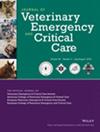Frequency and Number of B-Lines Using a Point-of-Care Thoracic Ultrasound Examination in Pet Rabbits (Oryctolagus cuniculus) Without Pulmonary Disease
Abstract
Objective
To assess the accuracy of a point-of-care thoracic ultrasound examination for the evaluation of the pulmonary parenchyma in rabbits without lower respiratory signs using thoracic radiography or computed tomography (CT) as the reference standard. An additional objective was to establish a baseline frequency and number of B-lines in rabbits without pulmonary disease.
Design
Prospective, multicenter, clinical study from December 2021 to July 2023.
Setting
University teaching hospital and an emergency and specialty referral center.
Animals
Sixty-three pet rabbits (Oryctolagus cuniculus) without lower respiratory signs and with lungs verified to be healthy with radiography or CT.
Interventions
Rabbits were screened for signs of respiratory disease. A modified point-of-care thoracic ultrasound examination was performed on each conscious rabbit, followed by a thoracic radiography or CT study. The frequency and number of B-lines were statistically compared based on signalment, body condition score, and health status.
Measurements and Main Results
The overall frequency of B-lines was 33.3% (21/63) in rabbits without pulmonary disease. Most B-lines were categorized as single discrete artifacts. A single region was positive for B-lines in 17 of 21 rabbits, with 14 of them having a single B-line, two having two B-lines, and one having three B-lines. Two and three regions were positive in three and one rabbit, respectively. Cranial thoracic ultrasound revealed mediastinal tissue rather than pulmonary parenchyma in 61 of 63 rabbits.
Conclusions
This study evaluated a modified point-of-care thoracic ultrasound, including B-line frequency and distribution, and described what can be expected as a normal thoracic ultrasound in rabbits without pulmonary disease. Findings indicate that isolated B-line artifacts can be detected within the lungs of rabbits without pulmonary disease. Additional studies are needed to describe the pulmonary ultrasonographic features in rabbits with respiratory conditions and to determine the clinical use of this diagnostic technique in those cases.

 求助内容:
求助内容: 应助结果提醒方式:
应助结果提醒方式:


